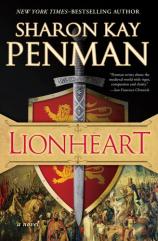Lionheart
Review
Lionheart
A former history major, I am nuts about the past, especially English kings and queens. But nowadays I get most of my history through fiction. Which is not as silly as it sounds, given that many historical novelists do meticulous research on the latest scholarly findings. As a result, their books often alter the conventional wisdom about celebrated personages and well-trodden events.
"LIONHEART kept me reading, rapt in the descriptions of a rough-and-tumble army camp or the sultry elegance of a Sicilian palace."
Richard III, for example, has been historically and fictionally rehabilitated (by Sharon Kay Penman herself in the novel, THE SUNNE IN SPLENDOR) now that Shakespeare’s portrait of him as an evil, child-murdering hunchback has been revealed as less than the whole truth. His forbear, Richard I, never had such a dire reputation, but he is usually portrayed as a remote warrior king who, after spending most of his life either on Crusade or in captivity, arrives back home just in time to save the country from his treacherous brother, Bad King John. (Of course, John has his own proponents.)
In an Author’s Note, Penman herself admits that “Richard I was never one of my favorite kings.” But that was before she delved into his life. Now she thinks well of the monarch, depicting him in LIONHEART not only as a legendary military genius (“I never feel more alive than I do on the battlefield,” he tells his wife), but a fair-minded and surprisingly progressive leader, politically shrewd but not lacking in integrity.
As LIONHEART begins, Henry II has died (you might remember him and his combative wife, Eleanor, from the film A Lion in Winter), and his remaining sons are jockeying for position. Richard and John, in fact, had allied with England’s archenemy, France, against their father. But almost as soon as Richard is crowned, he takes up a Crusade (Europe’s third) to reclaim Jerusalem for Christianity. The trek to the Holy Land, via Sicily and Cyprus, is packed with storms at sea, fierce battles, and even fiercer politicking (although Philippe of France is ostensibly Richard’s ally in this sacred mission, there is no love lost between them). Actually, Penman portrays Richard’s enemy, Saladin, as a more virtuous and noble ruler than any of the Europeans; their mutual respect is an example of 12th-century tolerance that certain factions in the 21st century would do well to imitate.
And it isn’t just the “infidels” who come off well. Although the novel is called LIONHEART, it is told at least as much from the point of view of the clever, forceful women in Richard’s life: Berengaria, the sheltered but stalwart Navarrese princess he marries; Eleanor, his ever-impressive widowed mother; and his sister Joanna, widowed queen of Sicily. These three have to deal with not only the vagaries of medieval travel (Berengaria and Joanna go all the way to the Holy Land with Richard, while Eleanor defends his interests closer to home) but also the limitations of their gender: “Women like them, however high of birth and resolute of will,” Eleanor muses, “would always be birds with clipped wings, unable to soar in a world ruled by men.”
Penman is obviously fired with enthusiasm for her material, much of it based on chronicles from Richard’s own time, and as always in her novels (this is the eighth, not counting her medieval mysteries), the story teems with color and life. The battle scenes are exciting, the love scenes touching, the political rivalries evocative of our own age (did anyone see the Republicans debating in Las Vegas?). As a sort of fictional bonus, besides Penman’s historically-based characters, there are a few invented ones who add charm and spice to the narrative: Morgan, Richard’s Welsh cousin, who is a link to Penman’s earlier trilogy (which I highly recommend) about the princes of that northern land; and Lady Mariam, the daughter of a Sicilian king and a Saracen slave girl, raised as a Christian, who underlines the differences between European and Eastern culture. (Naturally, these two fall in love.)
I did wince a bit at some anachronistic language here and there: Richard admits that he got angry and “lost it.” A soldier “checks out” a bordello. “How did I ever get so lucky?” a happy new husband asks. A woman is praised for not being “needy.” How did Penman, a self-described lover of “obsessive-compulsive detail,” allow these to slip by?
And why didn’t an editor encourage her to quicken the pace of the book? It isn’t so much the length (almost 6oo pages) that is problematic. Penman’s previous novels were equally fat, and I read and loved them all. But, according to the Author’s Note, she found there was too much material to devote just one volume to Richard, so this is only the first half of his story. Without the built-in limits of a single book, I fear that she moves too ponderously. The divided focus --- almost every scene is told from a different point of view --- doesn’t help, either. I had trouble keeping people straight and had to refer constantly to the list of characters provided at the beginning. Perhaps this time Penman was guided a little too narrowly by her research and was unable to let her imagination roam free.
Yet I’m impressed by the author’s total commitment to the world she is re-creating. LIONHEART kept me reading, rapt in the descriptions of a rough-and-tumble army camp or the sultry elegance of a Sicilian palace. It gave me a fresh sense of Richard, and the sequel, A KING’S RANSOM, will surely yield further insights and revelations. I have no doubt that Penman will keep on retelling the history of England as long as there are royals awaiting her golden touch. Long may she reign.
Reviewed by Kathy Weissman on November 3, 2011
Lionheart
- Publication Date: October 4, 2011
- Genres: Fiction, Historical Fiction
- Hardcover: 608 pages
- Publisher: A Marian Wood Book/Putnam
- ISBN-10: 0399157859
- ISBN-13: 9780399157851





